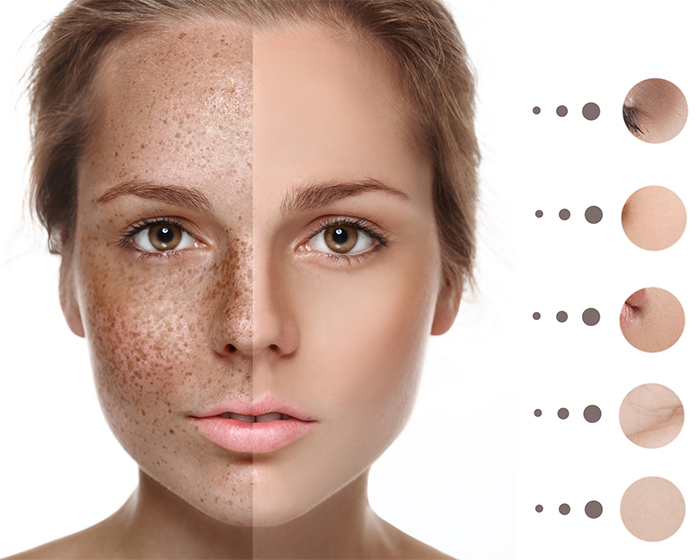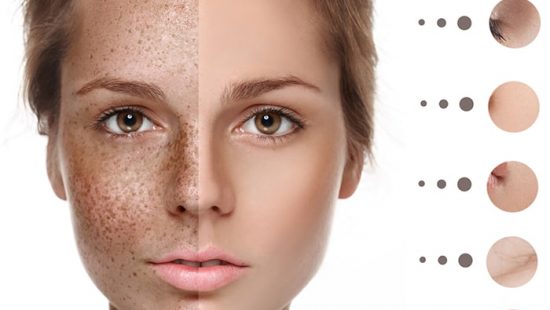Chemical Peel
in general, chemical peels are one of the most common and effective treatments for reversing sun-damage and slowing down the natural aging process. If you are interested in having a chemical peel, this guide will help you learn more about the process so that you can decide whether it’s the right cosmetic procedure for you.
Description ( Overview)
A chemical peel is a skin resurfacing and exfoliating technique used to selectively remove the thin, top layer of skin. A chemical solution is applied to the skin which causes it to exfoliate and “peel off” the outer layers, resulting in the growth of a newer, brighter, and smoother layer of skin, encouraging a faster rate of collagen production to occur naturally. Chemical peels serve to both remove brown/red discolorations of the skin as well as remove fine wrinkles thereby creating a younger appearing skin and more even skin tone.
There are many chemical peels available that range from superficial to deep.
In general, the type of chemical peel you choose will depend on the desired depth of penetration, your desired outcome, and the length of recovery time you are willing to commit to. Typically, the deeper the peel, the greater the results, but deeper peels are also associated with longer recovery periods and a higher risk of developing side effects.
Why Chemical Peel Is Reguired ?
Chemical peels can be performed to improve the appearance of the face, neck, and hands, but are most commonly utilized to improve facial skin. Depending on the intensity of the chemical peel, the procedure can erase or reduce a wide range of skin ailments, including:
Wrinkles and fine lines
Sun damage
Signs of aging
Skin discolorations
Blotchiness
Hyperpigmentation
Age spots, brown spots, and freckles
Light scarring
Certain pre-cancerous skin growths
Melasma
Crow’s Feet
Why Iran Is Suitable For Chemical Peel ?

Patient Eligibility \ Who Can Have Chemical Peel ?
hemical peels are suitable procedures for people of all types of skin colors and textures, though people with lighter skin colors will tend to have the best results. Those with darker skin tones will also see improved skin after a chemical peel, though there may be a greater risk for uneven skin tone or some dark spots after it’s completed.
Notify your doctor of any cosmetic procedures you have had in the past and any medication you have taken recently. Be sure to tell your doctor if you have been using a retinoid cream like Retin-A, as these can enhance the penetration of some chemical peels.
Who is Not a Good Candidate for This Procedure?
While chemical peels can work exceptionally well on many different types of skin, this cosmetic procedure is not suitable for everyone. First and foremost, patients should have realistic expectations of what their results might be after the procedure. In particular, they should know that chemical peels will not decrease pore size, eliminate deep scars, and there is a risk of discoloration of the skin after the procedure is done. It should also be noted that the risk of hyperpigmentation (darkening of the skin) and hypopigmentation (lightening of the skin) is higher for patients with darker skin tones, and the changes in the skin could be permanent.
A chemical peel may not be recommended for anyone with:
– An active skin disease
– Infections
– Sunburn
– Broken skin or cuts
– Frequent or severe outbreaks of cold sores
– Psoriasis
– Eczema
– Rosacea
– Dermatitis
The treatment would also not be suitable for anyone pregnant or nursing, uses prescription skin care products, or has used bleach or acid-based products in the last 48 hours. If you’re interested in having a chemical peel and have one of the previously mentioned symptoms or skin issues, speak with your medical professional to discuss your options.
How Is Chemical Peel Done? (Procedures)
There are three main types of chemical peels:
Superficial Peel: Also known as a lunchtime peel, this treatment uses a mild acid such as alpha-hydroxy acid to penetrate only the outer layer of skin. This light chemical peel gently exfoliates to improve the appearance of mild skin discoloration and roughness. It also refreshes the face, neck, chest or hands.
Medium Peel: This treatment penetrates deeper, through the outer layer and into the middle layer of skin to remove damaged skin cells. A stronger acid is used such as glycolic or trichloroacetic acid. These can improve age spots, reduce fine lines, wrinkles, freckles, and skin discoloration. A medium peel can also smooth rough skin and even treat some precancerous skin growths such as actinic keratosis.
Deep Peel: This facial procedure uses trichloroacetic acid or phenol which penetrates deep into the middle layer of skin, removing damaged skin cells. This deep peel treatment removes moderate lines, freckles, age spots, and scars. It results in dramatic improvements in the appearance of treated skin, but it can only be performed once.
What is the Procedure Like?
In a typical chemical peel procedure, the ideal chemical is chosen for the desired depth of penetration. For deep peels, a local anesthetic will be administered to block pain and a sedative to relax before treatment begins.
For all depth levels, the skin will be thoroughly cleansed before the administration of the solution. Once the skin is cleaned and prepared for treatment, the appropriate chemical solution is then applied to the desired areas. For light peels, the most commonly used chemical solutions are mild and may include combinations of alpha hydroxy acids and beta hydroxy acids, which will be brushed onto the face or other areas and left for just a few minutes. For medium peels, stronger chemicals like trichloroacetic acid (TCA), Jessner’s Solution, and glycolic acid are the most frequently applied chemical solutions. Phenol is the most commonly used chemical for deep peels, and the length of the application will be determined by your doctor.
The candidate is closely observed for changes to the skin. Whitening of the skin is monitored to assess epidermal damage and the procedure will be stopped at any signs of epidermolysis or erythema, which could signify rapid deterioration of the skin. As the peel progresses and the skin begins to take on a frosted appearance, this will indicate a deeper depth of penetration into the dermis and the ideal result.
Once the appropriate amount of time has elapsed, the solution is then neutralized with another agent such as sodium bicarbonate. Some lighter peels do not require neutralization, as the skin naturally neutralizes them. The skin is then cleansed, and various dressings such as silicone may be applied. Thick ointments or emollients like petroleum jelly can be utilized after the peel has completed as a protective barrier. This is more common for deep peels and is typically not necessary for the most superficial peels.
Preparation & Recovery
For patients having deep peels, your medical professional might implement a retinoid cream (tretinoin) treatment process up to eight weeks before the procedure begins to shorten treatment time and speed up the healing process, or using a bleaching agent (hydroquinone) and a retinoid cream (tretinoin) before or after the procedure to prevent skin darkening.
If the patient has a history of herpes infections around the mouth, an antiviral medication will likely be prescribed before and after treatment to help prevent a viral infection.
How Long Does it Take to Recover from a Chemical Peel?
Recovery time after a chemical peel can range between 0-3 months, depending on the invasiveness of the procedure.
A light, superficial peel takes one to seven days to heal. Treated skin will be red and may scale initially, so lotion should be applied until the skin heals. Sunscreen should then be used every day. Makeup can usually be worn the day after treatment.
Medium chemical peels can take up to 14 days to heal. Treated skin will be red and swollen initially, and swelling can worsen in the first 48 hours. Patients may experience blistering of the skin and eyelids swelling shut. Skin must be soaked daily, and ointment should be applied afterward. Exposure to the sun should be avoided during recovery time, and camouflage makeup can be worn five to seven days after the treatment. A follow-up appointment is necessary to monitor progress.
After a deep chemical peel, the treated area will be bandaged, requiring up to 21 days to heal. The skin must be soaked up to six times a day, and ointment must be applied for the first fourteen days. Sun exposure should be avoided completely for three to six months. It is necessary to have several follow-up appointments to monitor recovery.
To alleviate discomfort, ice packs or the breeze from a fan may be used for comfort as well as over-the-counter pain-relieving medication, such as ibuprofen (Advil®, Motrin® IB, and others) and naproxen sodium (Aleve®, among others). As swelling decreases treated, the skin will begin to form a crust and might darken or develop brown blotches. After a deep chemical peel, it is normal to experience severe redness, swelling, burning, throbbing, and eyelids might swell shut.
Other Options
Risks & Complication
Side effects from a chemical peel vary based on the type of peel. For lighter peels, the most common side effects include hyperpigmentation and infection. For medium peels, hyperpigmentation is also a common side effect, along with prolonged redness and a slight but possible chance of permanent scarring. Patients having deeper peels should be aware of the possibility of all of the above side effects, as well as a slight but possible risk of heart, kidney, or liver damage.

